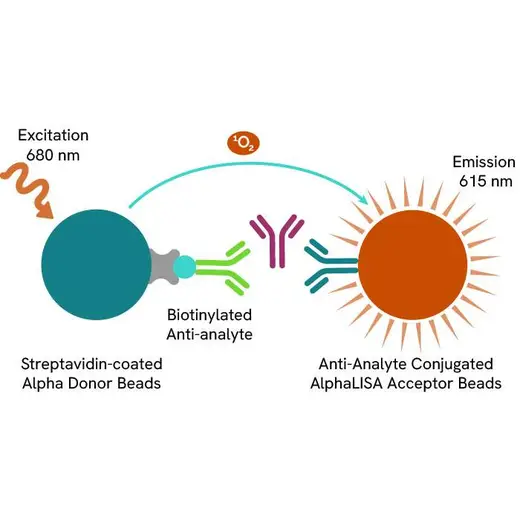
AlphaLISA Human PDL2 Detection Kit, 5,000 Assay Points


 View All
View All
AlphaLISA Human PDL2 Detection Kit, 5,000 Assay Points














The AlphaLISA™ immunoassay kit for human PD-L2 enables the quantitative determination of human programmed death 1 ligand 2 (PD-L2) in serum and over-expressing cell lysates using a homogeneous AlphaLISA assay (no wash steps).
For research use only. Not for use in diagnostic procedures. All products to be used in accordance with applicable laws and regulations including without limitation, consumption and disposal requirements under European REACH regulations (EC 1907/2006).
| Feature | Specification |
|---|---|
| Application | Protein Quantification |
| Dynamic Range | 202 - 3,000,000 pg/mL |
| Limit of Detection | 202 pg/mL |
| Limit of Quantification | 672 pg/mL |
| Sample Volume | 5 µL |
The AlphaLISA™ immunoassay kit for human PD-L2 enables the quantitative determination of human programmed death 1 ligand 2 (PD-L2) in serum and over-expressing cell lysates using a homogeneous AlphaLISA assay (no wash steps).
For research use only. Not for use in diagnostic procedures. All products to be used in accordance with applicable laws and regulations including without limitation, consumption and disposal requirements under European REACH regulations (EC 1907/2006).







AlphaLISA Human PDL2 Detection Kit, 5,000 Assay Points







AlphaLISA Human PDL2 Detection Kit, 5,000 Assay Points







Product information
Overview
Formats:
- Our 100 assay point kit allows you to run 100 wells in 96-well format, using a 100 µL reaction volume (10 µL of sample).
- Our 500 assay point kit allows you to run 500 wells in 96-well or 384-well format, using a 50 µL reaction volume (5 µL of sample).
- Our 5,000 assay point kit allows you to run 5,000 wells in 96-well or 384-well format, using a 50 µL reaction volume (5 µL of sample).
AlphaLISA features:
- No-wash steps, no separation steps
- ELISA alternative technology
- Sensitive detection
- Broad sample compatibility
- Small sample volume
- Results in less than 3 hours
- Half the time of an ELISA assay
AlphaLISA technology allows the detection of molecules of interest in buffer, cell culture media, serum and plasma in a highly sensitive, quantitative, reproducible and user-friendly mode. In an AlphaLISA assay, a Biotinylated Anti-Analyte Antibody binds to the Streptavidin-coated Alpha Donor beads, while another Anti-Analyte Antibody is conjugated to AlphaLISA Acceptor beads. In the presence of the analyte, the beads come into close proximity. The excitation of the Donor beads provokes the release of singlet oxygen molecules that triggers a cascade of energy transfer in the Acceptor beads, resulting in a sharp peak of light emission at 615 nm.
Programmed Cell Death 1 Ligand 2 (PD-L2), also known as cluster of differentiation 273 (CD273) or B7-DC, is one of 2 ligands that binds to programmed death 1 (PD-1), the other being programmed cell death ligand 1 (PD-L1). These two ligands are members of the B7 superfamily that provide signals for regulating T-cell activation and tolerance. PD-L2 is expressed on a subset of dendritic cells, memory B cells, and monocytes in tissues, where its highest expression has been proven to be on the liver, heart, placenta, spleen, pancreas, and lymph node. The binding of PD-L2 and PD-1 promotes IFN-gamma production and CD40 ligand up-regulation while inhibiting IL-4 production.
Specifications
| Application |
Protein Quantification
|
|---|---|
| Brand |
AlphaLISA
|
| Detection Modality |
Alpha
|
| Dynamic Range |
202 - 3,000,000 pg/mL
|
| Limit of Detection |
202 pg/mL
|
| Limit of Quantification |
672 pg/mL
|
| Product Group |
Kit
|
| Sample Volume |
5 µL
|
| Shipping Conditions |
Shipped in Blue Ice
|
| Target |
PD-L2
|
| Target Class |
Biomarkers
|
| Target Species |
Human
|
| Technology |
Alpha
|
| Therapeutic Area |
Oncology
|
| Unit Size |
5,000 Assay Points
|
Image gallery






AlphaLISA Human PDL2 Detection Kit, 5,000 Assay Points






AlphaLISA Human PDL2 Detection Kit, 5,000 Assay Points






Video gallery

AlphaLISA Human PDL2 Detection Kit, 5,000 Assay Points

AlphaLISA Human PDL2 Detection Kit, 5,000 Assay Points

Resources
Are you looking for resources, click on the resource type to explore further.


How can we help you?
We are here to answer your questions.






























